What Would You Put In A Bigfoot Display?
Posted by: Loren Coleman on October 8th, 2008
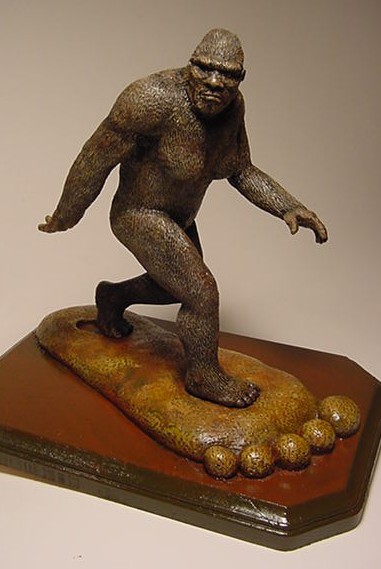
I’m always adding new items to the museum. The Bigfoot collectibles, like Jeff H. Johnson’s sculpture of the Patterson-Gimlin Bigfoot (above), outnumber all the rest. Johnson’s art is one such object, a resin model, and not exactly a toy.
So, how does one pick and choose? How about some public opinion here on what is appreciated in museums?
What do you like to see in exhibition cases when you visit your neighborhood cryptozoology and Bigfoot museum?
Over the weekend, I drove up to the Center for Contemporary Art in Rockport, Maine to pick up a donation from installation artist Tyler McPhee.
Tyler McPhee was breaking down his exhibit recreating part of a Bigfoot museum. This involved moving along two display cases he had recycled himself from the anthropology museum at the University of Maine in Orono. He passed them on to me for the International Cryptozoology Museum, if I would come and pick them up. With the assistance of museum volunteer Jeff Meuse and my son Caleb doing all the heavy lifting at this end, the huge cases were moved into my Portland location last Sunday.
Now, how to utilize them? Of the hundreds of items I have to choose from, what should I place in the cases? And how to make the displays presentable before the film crew from MonsterQuest arrives at my door the middle of next week?
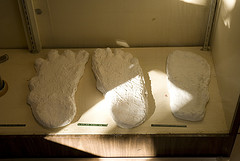
McPhee’s use of this display case involved showing photos of Yeti images at one end, and here, at the right end, the Bossburg casts and another one attributed to Roger Patterson.
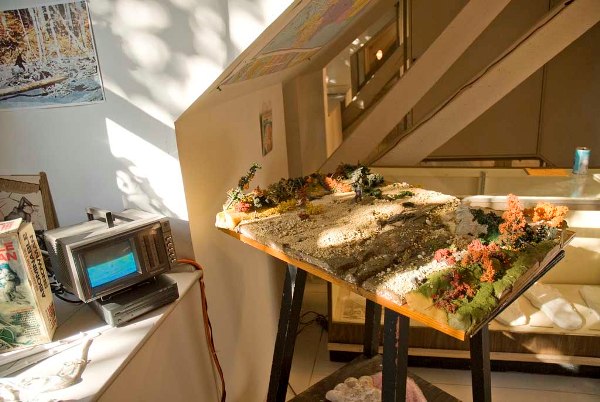
You can see the hint of one of the Rockport display cases behind McPhee’s “In Search Of” model of the Patterson-Gimlin footage scene shoot at Bluff Creek.
Some uses of display cases can be quite nice, especially in well-funded institutions. Just take a look at what the Phoebe Hearst Museum of Anthropology, Berkeley, California, did with a short (February 8th-29th, 2008) exhibit of two Bigfoot casts, which had been donated by Grover Krantz to their collection. These happen to be the same two Bossburg casts shown in McPhee’s display above.
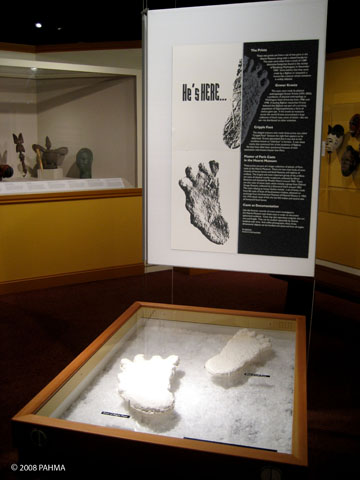
What the Berkeley museum, as well as the exhibition “Cryptozoology Out of Time Place Scale” shown at Bates College’s Museum of Art and Kansas City’s Art Institute (as shown below) had going for them were flat display cases, lots of space, and money. (All items displayed are from my collection.)
For display cases that have more height than depth or width, it sometimes looks rather strange to have only long flat footcasts in tall cabinets (without thinking about other objects in the case).
Above and below is Bigfoot historian Al Hodgson at the Willow Creek – China Flats Museum in northern California. You can see that museum has some tall display cases. (Photos: Paul Vella/Jerry Riedel & Bigfoot Museum)
At the 2006 Bigfoot exhibition at the University of Texas San Antonio’s Institute of Texan Cultures, some casts from Craig Woolheater collection were placed in long, wide cases (as shown below) and and others’ objects in a couple taller clear ones viewable from all sides filled with stone carvings, skull replicas, and busts.
I am standing next to the long line of Texas’ display of Bigfoot casts.

Photo courtesy of Chris Buntenbah
At the Bates College exhibition, the curators had one central taller display case with larger items in it. The case was a great way to show all sides of the skull models and artist Dick Kylver’s bronze of Patty (below), which, once again, are items from my collection.
The McPhee donated-cases are tall with viewing through the front and top. What would you put in them? How would you set up the new cases? With one theme? A mix? I am interested in your ideas.
What have you enjoyed in the past at Bigfoot museums? Or wished you would see in the future (other than, of course, the actual body of a Bigfoot/Sasquatch on exhibition)?
This is your chance to sound off on what you would like to see on display in a Bigfoot or cryptozoology exhibit. What are your choices for the two new glass museum cases at the Portland, Maine museum?
Thank you.
+++++
Sign up today for “Bene-Foot: The Comedy Benefit…” coming November 22nd.
About Loren Coleman
Loren Coleman is one of the world’s leading cryptozoologists, some say “the” leading living cryptozoologist. Certainly, he is acknowledged as the current living American researcher and writer who has most popularized cryptozoology in the late 20th and early 21st centuries.
Starting his fieldwork and investigations in 1960, after traveling and trekking extensively in pursuit of cryptozoological mysteries, Coleman began writing to share his experiences in 1969. An honorary member of Ivan T. Sanderson’s Society for the Investigation of the Unexplained in the 1970s, Coleman has been bestowed with similar honorary memberships of the North Idaho College Cryptozoology Club in 1983, and in subsequent years, that of the British Columbia Scientific Cryptozoology Club, CryptoSafari International, and other international organizations. He was also a Life Member and Benefactor of the International Society of Cryptozoology (now-defunct).
Loren Coleman’s daily blog, as a member of the Cryptomundo Team, served as an ongoing avenue of communication for the ever-growing body of cryptozoo news from 2005 through 2013. He returned as an infrequent contributor beginning Halloween week of 2015.
Coleman is the founder in 2003, and current director of the International Cryptozoology Museum in Portland, Maine.

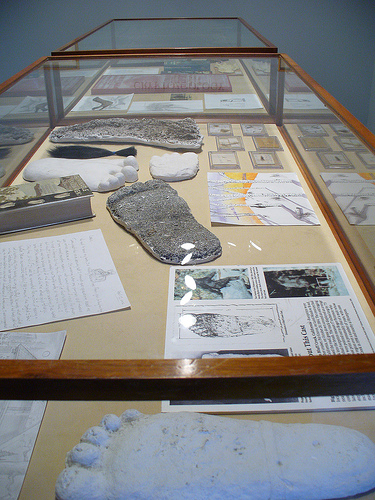
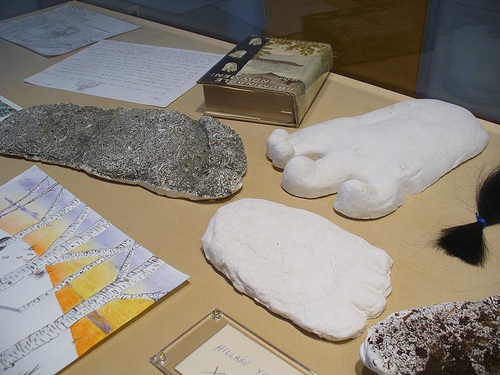
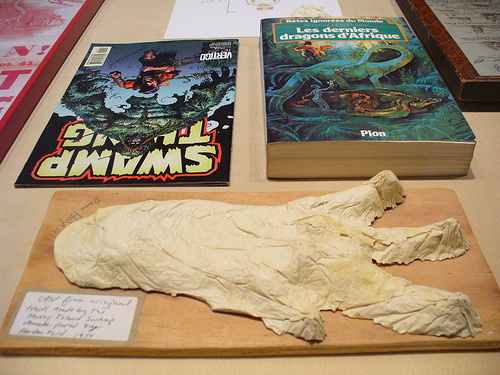
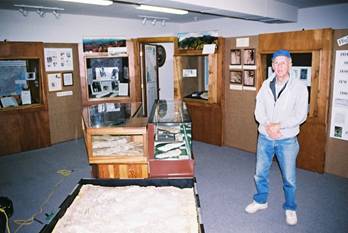
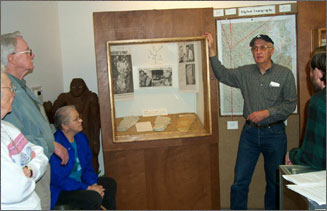
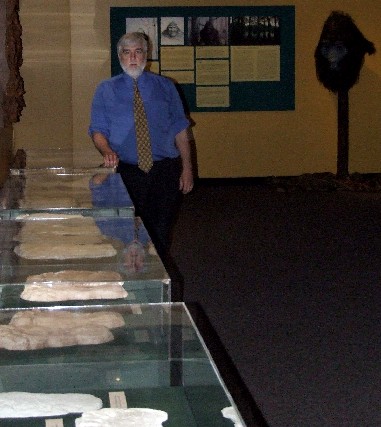
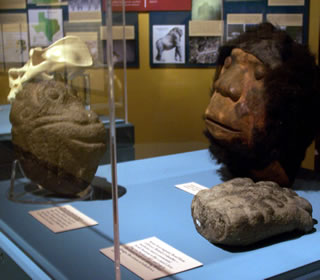
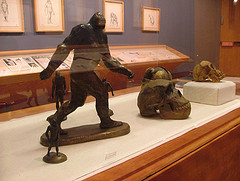
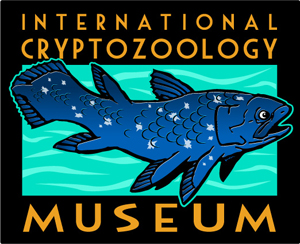









Loren, you are on the right track with the idea of different types of items in the cases. My experience with design and even exhibit design has taught me that scale will create interesting layouts. So by making sure you have items of different sizes will help. I also think that what makes those examples you show from other museums successful is the use of open space. That might be difficult since I know how many items you do have and need to display.
My suggestion is to tell a story which is what you are great at. Maybe a timeline type display starting at one end and working down. If you can devote the new space specifically to one topic and keep it simple I think you will have a winner.
Mike Esordi
Models and info on the various suspected hominids and apes that are hypothesized to be responsible for sightings in various regions.
I would like to see a display showing models/illustrations/whatever of our best guesses of Sasquatch and the two best bets for their ancestors, which in my book are Gigantopithecus and Paranthropus. The models/ illustrations should demonstrate relative sizes, similarity of features, etc. (I know, lots of guesswork, but I did specify best guesses). I’ve never seen such a side by side comparison and think it would be well worthwhile.
For kids (and kid-like adults), I’d love to see “Bigfoot” sized footprints going from display to display. It gives a perspective, especially if the stride size is accurate. It shows how hard it is for a person in “fake feet” to jump from stride to stride through the woods. I’d also love to see a life-sized Gigantopithecus and perhaps what is estimated life-sized Bigfoot side-by-side. The thing that gets people thrilled about Bigfoot is his massive size and strength. Making that palpable for visitors will give them a visceral reaction.
I think space is warranted for display of a series of casts: a few of the most authoritative bigfoot casts, such as Bossburg, next to casts from the largest of the known primates: A Homo sapiens foot, a gorilla foot, a Neanderthal foot, and an H. erectus foot (I don’t believe that we have an undisputed Paranthropus footprint, do we? Include it if there is one.)
I like the idea of the bigfoot-prints-stride between the displays.
I’d say put rare and fragile items in them that people would like to get up close to look at and this way you wouldn’t have to worry about damages to them. I like the idea of having one with different footprints (labeled of course) perhaps ones from different areas of the US as well as different countries so that people can see differences, perhaps accompany these with well done drawings to show more of the differences.
I think it’d be awesome to have models, to scale, of the various types of cryptid primates displayed together in a miniature diorama.
For the museum:
A wall-sized map of locations of bigfoot sightings (one for US, one for world).
Oral history collection of videos of people describing their sightings.
Other examples of claimed evidence (hair, scat, taped vocalizations)
I would go very lightly on the “bigfoot in pop culture” kinds of materials. Stress what it is or may be, not how it may be seen.
Well, for an exhibit, I would love to see an skeleton of Bigfoot! 🙂
Ok, ok, using what you already have: would it be possible to install a little webacam on the McPhee’s “In Search Of” model? Without compromising the piece of course, but I think it would be pretty cool to display a live image of the model on a tv screen, recreating just the same viewpoint of the P-G film.
I also would like to have a nice diorama or map of the continental United States, with pins pointing out the places and dates of the most reliable sightings. Maybe it would be easier with a computer program.
For the kiddies, how about a “what would Bigfoot eat?” dsplay? Also, if I were a kid, I would love to compare my foot size with one of the casts 😉
Well, first I must say, I am very impressed at what you already have accomplished with the display you already have! Beautiful!
With that being said, there are several different ways you could go with this. You could do a display based on the chronological history of events and the BF phenomena. That would be one way to go. Or you could categorize the exhibit. You could have a photo section, a track or cast section, or even a replica section. The track or cast section could be part of a larger evidence section with hair samples or scat samples. You could also set it up by continent and the sightings on those continents and do a comparison between sightings. You might want to have a map and where sightings have occurred in the US and when they occurred over history. There might be seasonality to the sightings, hinting at BF migrations related to change in the seasons.
There are so many different ways you could go with this! One common thing I noticed when visiting museums, is that I tend to like museums which educate by comparative examples. Let me explain. If you have a cast of a BF track on display, you may want to have a verified hoax track, one that is considered genuine and then another example from another country. There should be some verbage there to explain the differences, the similarities, etc. It educates the visitor. It is helpful to adults and children in understanding what the message is that you are trying to convey.
Which brings up marketing to coincide with a successful display. Museums survive because of curiosity. Most people will not admit interest or to curiosity in BF publicly. However, the kid in them will be drawn to this type of museum. Adults have the disposable income. Children do not. But probably more than half the visitors to the museum might be children. Why? Adults will bring the children and use them as the excuse for they themselves, visiting the museum. They will claim it is for “educational purposes” for the “children”. Either way it is fine because the adults have the money to spend, whether it be on themselves or using the children as an excuse. They will come!
I would also tie in some of your own theories Loren. I would encorporate into the display Gigantopithecus blacki and other theories you have proposed in the past. Theories give rise to thought in visitors. It stimulates their imagination. Imagination starts the investigative and educational process. What if? What are the possibilities? Which theory do I subscribe to? This will keep people coming back. If the museum provokes thought, people will remember the museum after leaving the museum. They might want to come back a visit a couple of times, as opposed to visiting once and claiming, “I know about BF”.
In that same vein, I visit aquariums and zoos for the same reason. I might go to the aquarium if a new animal or exhibit opens. However, I may and have returned before a new exhibit opens, if my curiosity has been aroused by something I saw on a prior visit. The same applies to zoos. I saw the new chimpanzee exhibit. I would go back if there was a new birth to a chimp family. Of course everyone else would probably go back for that occassion. But what would want me to desire to return on my own? That is the question! I might have witnessed a behavior on that initial visit. I might go home and search for the behavior on the internet. I might go back to test my theory on the explanation of the behavior I witnessed. I would do that on my own because that behavior initiated me thinking about it. Properly set up, a museum will invoke that same thought process in the visitors. And that is how a museum becomes self sustaining. People come back out of want and need, rather than publicity and advertising efforts.
You could do the same thing with the photo section. You could have a verified hoax photo, an authentic one, and a blobsquatch.
If I were setting up the display, I would like to see as a visitor, a chronological history, broken down geographically, with comparative museum pieces for viewing.
But let’s face it, every person is different and thinks differently. What might appeal to me and my logic, may not appeal to another. You can’t please all the people all of the time. But you asked. I answered. I hope my input was helpful in some small way. But what you have there Loren is gold! It is beautiful already!
Don’t forget the beef jerky!
I agree with Bigfoot Surplus in that a timeline display would be very interesting. What was found long ago and various pieces (casts) and documents displayed leading up to more recent events.
Matt Bille is spot on with the casts display idea and featuring the stride between displays.
Being that it is the International Cryptozoology Museum I think a regional display of sorts is a good idea. Depending on space and area available, display what is found and reported from various parts of the world, or if it is strictly the North American Bigfoot, display regional findings for the United States and Canada.
Just my two cents. Good luck!
You know, that beef jerkey company and the outfit with the trail cam challenge might make good -sponsors- for the museum. . .
I’m seeing some great ideas.
My only (silly?) concern is that it would enable hoaxers to learn how to do a better job, but I think that is inevitable.
I would put one of these
caniswalensis, that is AWESOME! I have to have one of those!
sschaper, I wrote an inquiry to them on fundraising, I’m waiting for a response, great idea!
I’m very big into collecting and painting 25mm to 28mm scale pewter wargaming figures, and over the years the various companies that sell these figures have released Bigfoot related figures. Grenadier had a great Yeti figure and some very popular Wendigo figures. Reaper Minis has several Bigfoot related figures, including a Patty.
Personally bigfoot stuffed and mounted next to a yeti and wendigo also stuffed and mounted.
Couldn’t you just have the Bigfoot, Yeti, and Wendigo shaking hands?
Older cultural material, reminding that Sasquatch wasn’t invented by the National Enquirer in the 70s;
Photos of totem pole faces, posters with large-type quotes from literature, a huge list of local names, etc.
A poster of the great apes (including us), reminding that S. isn’t a thing of myths, he’d be the 6th one on the block.
And a Skeptic in captivity 😉
And you do have books and keepsakes for sale, right?
* My idea will blow you away, if you can get it. Can you get your hands on the recent DNA test that proved that human DNA was 99.99% human? That was the one from the flesh, hair and blood samples taken from Canada, from the screw board at the cabin.
* Show hair samples that prove it is human type hair, not an Ape’s. And show samples of colors. Sasquatch Itan is not just brown. Most don’t know that.
* Show the different foot fingerprints that prove they aren’t Apes. Chilcutt has them.
* How tall is your ceiling? Show paintings of how tall they can get, I’ve seen one 18 ft tall. The older they get, the taller they get.
* Show the reports from the whole world talking about how Sasquatch have taken human women for mates, and produced children. Show the report on Zana, in Russia, and the pictures.
* Show the reports related to UFO sightings, so people can see the relationship between them. There is one, that cannot be ignored or denied. Show the proof!!! I just wish there were pictures as well.
* Show the Psychic Sasquatch book, maybe even hand out free ones. It is a book well worth reading!!!
These are just samples. People need to learn that Itan are not Apes. They are human, and that has been proven.
Tianca